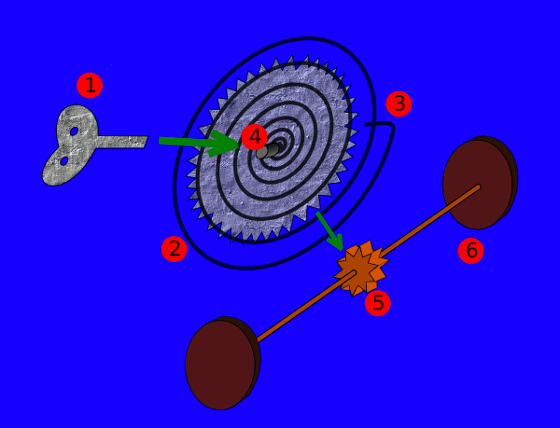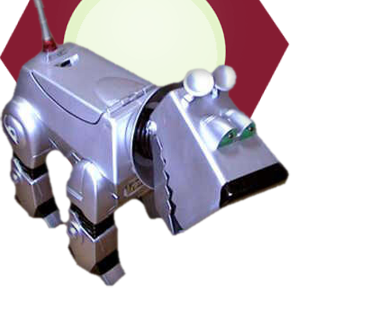Wind Up Mechanics: How To Make a Wind-Up Toy Yourself
Dissecting Mechanical Bodies For Fun and Knowledge
They are used all over the place - in wind up toys, cam and crank toys, or even in mechanical clocks. They are used to store kinetic energy just like the batteries are used to store electrical power.
Without the wind-up mechanisms we would not have any of these toys with keys, and perhaps this site would not exist. Which would be really sad. Fortunately, the wind up motors exist - even much earlier than batteries.
So, let's have some fun and find out how wind-up mechanics work and even how you could build one such motor yourself.
How Do They Work?
Let's look inside such a mechanism. Here's a simple one that powers a mechanical wind-up car in a very simple fashion:

- Number (1) in the graphic above is the key that winds up the motor. It's not absolute must - some toys use simple pullback motors. But most good wind-up toys have winding keys.
- The key us used to wind the spring (2). This spring is the battery of every wind-up toy. It's natural position is unwind, like shown in the graphic. With the key you can tighten it thus transferring the kinetic power from your fingers to the spring. This spring then has a stopper in the other end (3) which prevents the free rotation and makes sure the energy is stored in the spring. If you released this spring immediately it would quickly return to its natural position.
- Because of stop mechanisms in most wind-ups the spring doesn't get released until you push some button or pull a trigger or so. Once this is done, the spring starts unwinding. But it's attached to a main gear (4) - a rack-wheel that rotates when the spring unwinds.
- The rest is simple - the big rack-wheel is connected to another one (5) (in this case much smaller) and transfers its rotation to it. As the radius of the main gear is much bigger than the small gear (5) just one its rotation forces (5) to rotate about 10 times.
- The small gear (5) is directly connected to the spindle that holds the car wheels. So the rotation causes the entire car to move.
- Because of the friction between the wheels and the ground, and the car mass, the spring can't unwind super-fast, as it would unwind if there was no big to small gear transmission. So the spring unwinds slow letting the toy work for a while. And for the 10 or so rotations that the spring/main gear makes there are a hundred cycles that the car wheels make.
This graphic shows a really simple toy where the rotation transfers into another rotation. But using more gears, cams, camshafts, and cranks we can convert the rotation into some kind of straight movement. Using Geneva drive we can convert the continuous rotation into intermittent motion. And so on.
Most complex mechanical wind-up toys, and the mechanical clocks use 2 or more springs and many gears to transmit the power into complex motions.
How To Make One Yourself
What if you are so amazed by wind-up mechanics that you want to build one such motor yourself? Ready wind-up toys aren't expensive so it doesn't make much economical sense but who cares. It must be fun.
So, there are three main things you need to buy or make:
- Gears. You'll need a few of them for every toy you may want to make. The cost would be just $0.50 to $5 or so per gear, and they are usually sold in packages. It's hard to find gears made exactly for making toys so here are few things you could search for: clockwork gears, bags of gears for decoration, or mechanical spur gears etc. Of course if you are very enthusiastic you can try to make your own gears. For big motors it's not that hard - you can make wooden gears. Metal gears are harder for DIY but this and this pages may help you. This guide albeit not as good, is dedicated especially to making metal gears at home.
- Spring. You will need a good clockwork spring to power your motor. These springs are made of steel and essentially are just long and narrow rectangle steel sheets. Such springs would be available in some local hardware stores. It's hard to find them at retail on-line. Plenty of companies offer them wholesale in case you want to build that many clockwork motors :) And in case you are that keen on making one yourself take a look here.
- Key And finally you need a key to wind your spring. Again depending on your enthusiasm you can buy or make one. Here is one for $5.95 or many more, and of course you can find simpler ones cheaper. Making one yourself will require really good skills in working with metal.
So, that's it... Almost. You will have to plan and design the different gears, how they will transmit power to each other, and how will the toy move. If you plan to use cams things can get even more complex. But that's the fun you are looking for I guess.
Sources
Here are two more pages that made writing this guide possible. Check them out for more info:
- Clockwork motor explained on Wikipedia
- Clockwork (windup) mechanisms - excellent guide!


